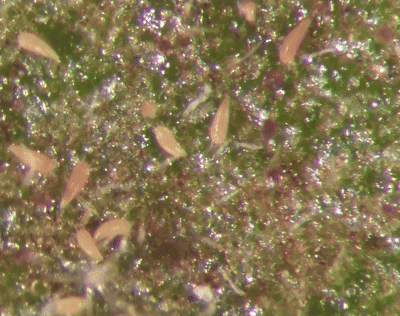Tomato Russet Mite
Tomato russet mites (Aculops lycopersici), also called rust mites, are a pest of solanaceous crops that are most common in greenhouses and high tunnels. They are eriophyid mites, belonging to a different family from most other common mite pests and exhibiting some distinct traits which affect identification and management. Identification is difficult due to their small size and damage, which resembles disease or nutrient deficiency, but early detection allows for effective control and prevention through cultural, biological, and chemical means.
Identification
 Russet mites grow to a length of 1/5 mm—less than half the size of the two-spotted spider mite (TSSM)—and cannot be seen without a microscope or powerful hand lens. Due to their size, this pest is often only detected after substantial crop damage has occurred. They have slender, cone-shaped bodies that are cream, tan, or yellow in color, with only two pairs of legs located at the front. Russet mites do not produce webbing as spider mites do.
Russet mites grow to a length of 1/5 mm—less than half the size of the two-spotted spider mite (TSSM)—and cannot be seen without a microscope or powerful hand lens. Due to their size, this pest is often only detected after substantial crop damage has occurred. They have slender, cone-shaped bodies that are cream, tan, or yellow in color, with only two pairs of legs located at the front. Russet mites do not produce webbing as spider mites do.
Life Cycle
When conditions are warm and dry, the entire life cycle may be completed in approximately 7 days. Populations grow quickly and can double in number every 3-4 days in conditions of around 80°F and 30% humidity. Eggs are laid on stems, petioles, and the undersides of leaves, usually on the lower portion of the plant. The larvae do not move far, but as the lower parts of the plant are damaged and depleted, adult mites will move up the plant to newer foliage. Mites in the upper leaves may be blown on wind currents to other plants.
Tomato russet mites do not have a dormant overwintering form and rely on the continuous availability of living host plants. Thus, infestations in Massachusetts are likely to originate from greenhouses and nurseries that remain in production throughout the winter.
Damage
Tomato russet mites feed on solanaceous plants by using their piercing-sucking mouthparts to puncture plant tissue. Damage may resemble disease or nutrient deficiency. Symptoms typically begin on the lowest parts of plants and move upwards, with browning on the stem near the soil often being among the first signs of infestation. Unlike many other mite pests, russet mites tolerate heavy sunlight and can be found on both the top and undersides of leaves. Feeding causes leaves to curl and turn yellow or bronze, sometimes with a glossy appearance on the undersides of leaves. Heavy pest pressure may cause leaves and petioles to wither and die while the stem remains intact but with a similar bronze or brown discoloration. Fruit may appear stunted and dark in color.
Management
Cultural control
- Scout regularly for symptoms of tomato russet mite damage.
- Ensure adequate irrigation and regulate temperatures inside high tunnels and greenhouses using shade cloth and ventilation to avoid hot and dry conditions which favor mite pests.
- Control weeds, specifically solanaceous weeds (e.g., nightshade, horsenettle, jimsonweed, etc.) and bindweed, which can also serve as hosts for tomato russet mites, in and around greenhouses.
- Avoid growing ornamentals and vegetables in the same greenhouses, as petunias are also a host of tomato russet mites.
- Limit traffic from infested to susceptible fields to prevent the spread of mites which are easily carried on clothing and equipment.
Biological Control
The predatory mite Amblyseius andersoni can be effective in greenhouses and high tunnels for preventing infestation or controlling low pest numbers. This predator additionally provides control of broad mites and two-spotted spider mites but may require repeated releases to maintain its populations. Wait 48 hours after chemical application before releasing predatory mites.
Chemical Control
Sulfur materials (e.g., Microthiol Disperss) are effective and OMRI-listed but should not be used when plants are flowering or when temperatures will exceed 90°F. Neem oil or azadirachtin may also be effective. All three of these materials must contact the mites to be effective, making good coverage of the foliage essential. See the outdoor tomato insect control section of the New England Vegetable Management Guide for labeled materials. Note: Movento (spirotetramat) cannot be used in greenhouse crops. Always check the label to ensure that greenhouse use is allowed and follow label instructions.
Crops Affected
The Center for Agriculture, Food and the Environment and UMass Extension are equal opportunity providers and employers, United States Department of Agriculture cooperating. Contact your local Extension office for information on disability accommodations. Contact the State Center Director’s Office if you have concerns related to discrimination, 413-545-4800 or see ag.umass.edu/civil-rights-information.